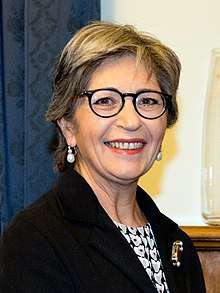Gentiloni Cabinet
| Gentiloni Cabinet | |
|---|---|
|
64th cabinet of Italy | |
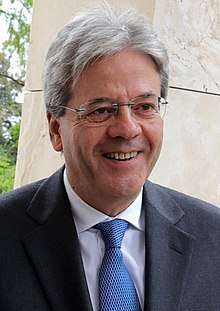 | |
| Date formed | 12 December 2016 |
| Date dissolved | 1 June 2018 (536 days) |
| People and organisations | |
| Head of state | Sergio Mattarella |
| Head of government | Paolo Gentiloni |
| No. of ministers | 17 |
| Ministers removed (Death/resignation/dismissal) | 2 |
| Total no. of ministers | 19 |
| Member parties |
Democratic Party (13) New Centre-Right (3) Centrists for Europe (1) Independents (2) |
| Status in legislature | Centre-left coalition |
| Opposition parties |
Five Star Movement Forza Italia Lega Nord Liberal Popular Alliance Brothers of Italy Italian Left |
| History | |
| Outgoing election | 2018 election |
| Legislature term(s) | XVII Legislature (2013–2018) |
| Predecessor | Renzi Cabinet |
| Successor | Conte Cabinet |
The Gentiloni Cabinet, led by Paolo Gentiloni, was the 64th cabinet of the Italian Republic.
The government, in office from 12 December 2016 to 1 June 2018, was led by Gentiloni's Democratic Party (PD). It originally included the New Centre-Right (NCD) and the Centrists for Europe (CpE) as junior partners, and also included non-party independents. The NCD was later folded into Popular Alternative (AP).
Background and formation
On 7 December 2016, Prime Minister Matteo Renzi announced his resignation, following the rejection of his proposals to overhaul the Senate in the 2016 constitutional referendum. A few days later, on 11 December 2016, President Sergio Mattarella asked Paolo Gentiloni, then Minister of Foreign Affairs, to form a new government.[1][1] On the following day Gentiloni was officially sworn in as the new head of the government.[2]
Gentiloni formed a coalition government supported by his own Democratic Party, the New Centre-Right and the Centrists for Italy. This was the same majority which supported Renzi's government for almost three years.[3] The centrist Liberal Popular Alliance, led by Denis Verdini, did not support the new cabinet, because no party member was appointed minister.[4] Deputy ministers of the Italian Socialist Party and Solidary Democracy were also appointed. After the split of the Democratic and Progressive Movement from the Democratic Party, that party was presented by one deputy minister in the government until 3 October 2017.
Investiture votes
Investiture votes for Gentiloni Cabinet | |||
|---|---|---|---|
| House of Parliament | Vote | Parties | Votes |
| Senate of the Republic | PD (109), NCD (32), PSI-SVP-MAIE (18), IdV (3), Others (9) | 171 / 320 | |
| FI (42), M5S (35), ALA (18), LN (12), GAL (11), CR (10), SI (8), F! (3), Others (7) | 146 / 320 | ||
| Chamber of Deputies | PD (301), AP (26), CeI (16), Demo.S-CD (13), Others (23) | 379 / 630 | |
| M5S (91), FI (50), SI (31), LN (19), ALA (16), AL-P (10), FdI (10), Others (13) | 240 / 630 | ||
Party breakdown
Beginning of term
Ministers
13 | |
3 | |
1 | |
2 |
Ministers and other members
- Democratic Party (PD): 13 ministers (incl. Gentiloni), 3 deputy ministers, 16 undersecretaries
- New Centre-Right (NCD): 3 ministers, 1 deputy minister, 10 undersecretaries
- Centrists for Europe (CpE): 1 minister
- Solidary Democracy (Demo.S): 2 deputy ministers
- Italian Socialist Party (PSI): 1 deputy minister
- Democratic Centre (CD): 1 undersecretary
- Civics and Innovators (CI): 1 undersecretary
- Independents: 2 ministers, 4 undersecretaries
End of term
Ministers
14 | |
2 | |
1 |
Ministers and other members
- Democratic Party (PD): 14 ministers (incl. Gentiloni), 2 deputy ministers, 16 undersecretaries
- Popular Alternative (AP): 2 ministers, 1 deputy minister, 8 undersecretaries
- Centrists for Europe (CpE): 1 minister
- Solidary Democracy (Demo.S): 2 deputy ministers
- Italian Socialist Party (PSI): 1 deputy minister
- Democratic Centre (CD): 1 undersecretary
- Civics and Innovators (CI): 1 undersecretary
- Independents: 3 undersecretaries
Geographical breakdown
Beginning of term
- Northern Italy: 9 ministers
- Emilia-Romagna: 4 ministers
- Lombardy: 2 ministers
- Liguria: 2 ministers
- Piedmont: 1 minister
- Central Italy: 7 ministers (incl. Gentiloni)
- Southern and Insular Italy: 3 ministers
End of term
- Northern Italy: 7 ministers
- Emilia-Romagna: 4 ministers
- Liguria: 2 ministers
- Lombardy: 1 minister
- Central Italy: 7 ministers (incl. Gentiloni)
- Southern and Insular Italy: 3 ministers
Composition
Beginning of term
End of term
Detailed composition
Prime Minister
| Portrait | Office | Name | Term | Party | |
|---|---|---|---|---|---|
 |
Ministers
Deputy Ministers
| Portrait | Office | Name | Term | Party | |
|---|---|---|---|---|---|
 |
|||||
 |
|||||
 |
|||||
 |
|||||
 |
|||||
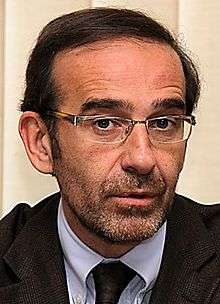 |
|||||
Secretary of the Council
| Portrait | Office | Name | Term | Party | |
|---|---|---|---|---|---|
 |
References
- 1 2 "L'ascesa di Paolo Gentiloni, dalla Margherita alla Farnesina" [Paolo Gentiloni's rise: from the Daisy to the Farnesina]. La Repubblica (in Italian). Rome: Gruppo Editoriale L’Espresso. 31 October 2014. Retrieved 20 February 2015.
- ↑ Nasce il governo Gentiloni, ministri confermati tranne Giannini. Alfano agli Esteri. Minniti all'Interno. Boschi sottosegretario
- ↑ Governo Gentiloni, il ministro scelto da Mattarella: “Stessa maggioranza, gli altri non ci stanno”. Lunedì la squadra
- ↑ http://www.corriere.it/la-crisi-di-governo/notizie/governo-denis-verdini-si-sfila-no-fiducia-governo-fotocopia-ae48522c-c091-11e6-84a3-703e0bacaa0c.shtml
- ↑ Martina resigned as Minister when he was appointed acting Secretary of the Democratic Party.
- ↑ Costa resigned due to contrasts with the Prime Minister. He often criticized Gentiloni's views and ideas, especially regarding immigration and birthright citizenship.
- ↑ Def, Speranza (Mdp): "No a relazione, sì a scostamento". Bubbico si dimette da viceministro repubblica.it. 3 October 2017.
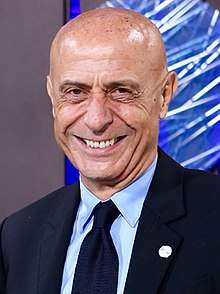

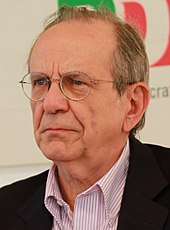
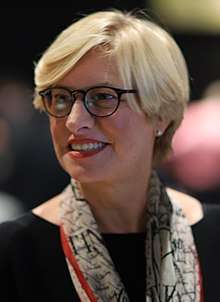

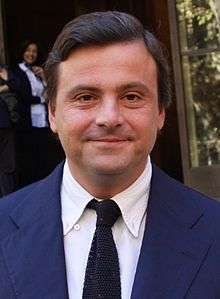





.jpg)


